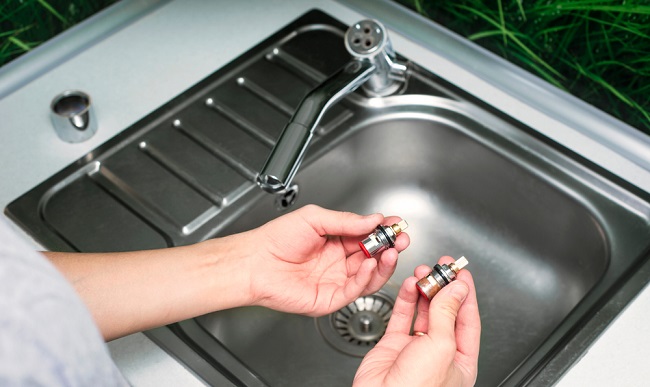Commonly used in both kitchens and bathrooms, cartridge faucets are a sort of washerless fixture that is designed to make repairs and replacements straightforward. These faucets come in both single-lever and two-handle variants, and various models employ different types of brass or plastic cartridges.
Single-handle faucets have a cartridge inside of them that can be raised and lowered with the help of the handle, causing the water to either cease or resume flowing. Both cold and hot water run into the same cartridge.

Two-handle cartridge faucets, on the other hand, feature two cartridges. One controls the hot water and the other controls the cold water in a similar method as single-handle devices. The cartridge’s major duty is to mix the cold and hot water streams, regulate the intensity, and maintain ongoing operation of the fixture.
Regardless of the sort of cartridge faucet you have, you may be asking how to detect if a faucet cartridge is bad. Well, we’re here to help! Let’s go through some of the most prominent indicators that a faucet cartridge has gone bad, along with how long they last, and the methods to replace a malfunctioning cartridge when it’s time.
Read Also:
- Patrick Ewing Says He has Tested Positive for Coronavirus
- Dallas Mavericks will Beat Unlikable Phoenix Suns in Seven Games
- What was Mr. Dennis Kozlowski (Manager of Tyco Company) Convicted for?
Contents
Telltale Indicators of a Faulty Shower Head Cartridge
One of the greatest symptoms that a faucet cartridge has gone faulty is when you have water seeping under the handle, the nut, or the valve.
In these cases, it’s likely that the lever won’t function well and it may become stuck in an unpleasant position. A dripping faucet could potentially signify that the cartridge needs to be replaced.
Generally speaking, a faucet cartridge is bad when you notice that it becomes difficult to change the water temperature. In extreme instances, you can have cold water entering the hot water outlets (and vice versa) (and vice versa).
The lack of sufficient stream strength, even when water pressure is normal, is another indication.
How Long Do Faucet Cartridges Last?
Faucets, whether for the kitchen or the bathroom, typically last between 15 and 20 years. This indicates that the cartridges included with these faucets will last about as long as those found in similar models.
The cartridge’s useful life, however, is affected by a wide range of variables, such as the tap’s build and the quality of the water being used.
A well-maintained item can last much longer before needing to be replaced than one that hasn’t been cared for properly.
However, there are a few warnings that your cartridge may be dead. The cartridge needs to be replaced before the faucet itself usually stops working.
Read Also:
- Angry Octopus Lashes Out at Man on Australia Beach
- Jeff Green ID Love to Settle Down in Brooklyn
- When to Switch From Infant Car Seat to Convertible
The Proper Method for Changing the Cartridge in Your Faucet
If your faucet is dripping, you can tell if the hot or cold water supply is to blame by touching the water (unless you have a single-handle faucet).
The faucet cartridge needs to be replaced solely on the leaky side. Both halves may need to be replaced if they are both leaking.
That being said, here are the measures you should do to swap out the cartridge(s) in your faucets:
- Turn off the taps. To begin, locate the shutoff valves under the sink and turn the handle clockwise to stop the water supply to the faucet you’ll be working on. Turning off the water supply at the main shutoff valve is necessary if your home does not have individual shutoff valves for each sink.
- To turn off the water, you need to remove the faucet’s handle. Depending on the design of your faucet, the screws holding the handle in place may be concealed by a stylish cap or the handle may be detached by unscrewing a lever at its base.
- It’s necessary to loosen the holding nut. Loosen the cartridge’s holding nut with a pipe wrench or tongue-and-groove pliers. Then take off the main body of the faucet. If the cartridge has a brass screw near the top, you may need to take it out and use it with the replacement cartridge.
- The old cartridge must be removed from the faucet. Take careful note of the present cartridge’s orientation; the replacement must be inserted in the same way. Pull the cartridge straight up to remove it from the faucet body.
- Invest on a new cartridge. Take the empty cartridge with you to the hardware store in order to obtain a matching replacement.
- A new cartridge must be put into the faucet. Replace the top cartridge screw (a little brass one) if it needs to be done. To replace a worn out cartridge, simply drop in a new one into the faucet body. To make sure the cartridge fits securely in the housing, you should push it in.
- Completion is the final step. Once you’ve installed the cartridge, replace the retaining nut and tighten it to keep it in place. To reassemble the faucet, replace both the handle and the decorative cover, if one was removed. Check the faucet’s operation after turning the water supply back on by moving the shutdown valve in the other direction (counterclockwise).